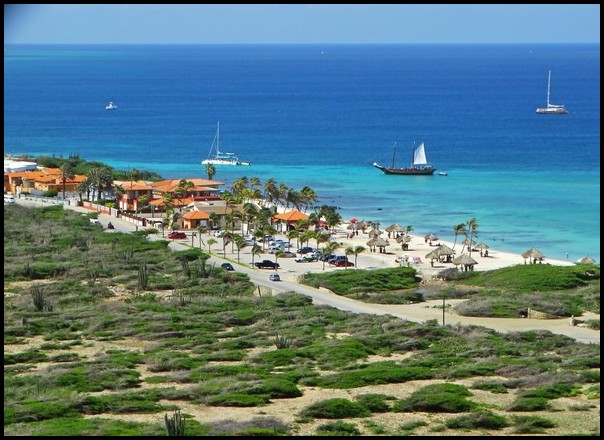
Natural Aruba:
All the Best Nature Places & Activities on the Island
Aruba is a small Caribbean island nation that’s located just off the north coast of Venezuela. It’s most famous as a beach vacation destination and is especially popular with Americans.
Aruba’s stunning powdery white sand beaches, swaying palm trees and clear aquamarine waters are many people’s epitome of a tropical island paradise. Not surprisingly, most travelers to Aruba visit the country primarily for its gorgeous beaches.
However, in addition to Aruba’s fabulous beach life, the island also has many other beautiful natural places that are well worth exploring. The island’s surprising natural diversity includes Arikok National Park, caves, cliffs, rock formations, salt-water lagoons, saltflats, sand dunes, tall cactus scrub, Hooiberg Hill and a variety of different kinds of beaches. Animals include several bird species, a bird sanctuary used by migratory birds, flamingoes, various lizards, wild goats and donkeys.
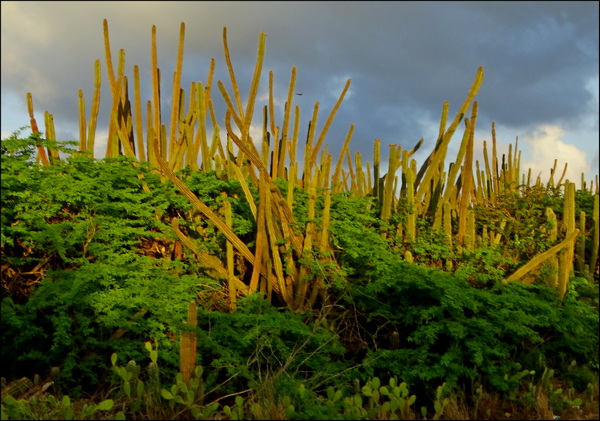
Aruba’s great natural diversity makes it a fantastic destination for nature lovers and outdoor enthusiasts. The island could easily keep such travelers busy for several weeks if they wanted to really see and do everything on offer.
I’m one of those outdoor enthusiasts and I’ve been busy exploring the island and immersing myself in its diverse natural environments for over one month so far. I haven’t seen everything yet, but I’ve seen a great deal thus far.
So I’m writing this article to detail Aruba’s amazing natural diversity and the many outdoor activities available on this beautiful Caribbean island. Read on…
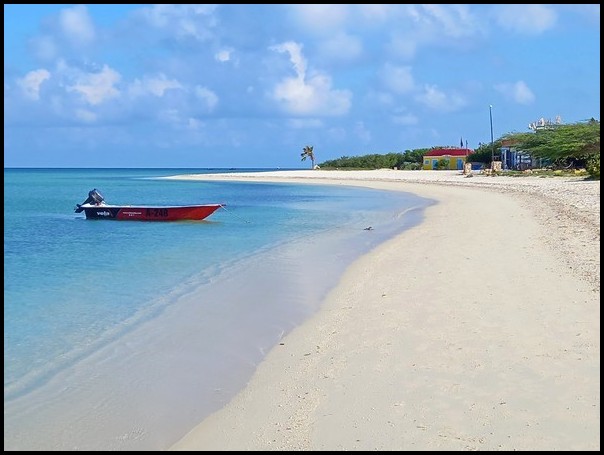
Enjoying Aruba’s Gorgeous Beaches
Since most vacationers to Aruba head there primarily for its stunning beaches, I’ll start with those.
The entire island of Aruba is lined by a series of beautiful powdery white sand beaches. Some are miles long. Others are set in small curved coves.
Beaches on the long eastern coast are pounded by constant trade winds, so are rough, windblown and have choppy seas. That coast has been left in a completely undeveloped state with no towns, no residential areas, no tourist development. There are some rough dirt roads, sight-seeing spots and Arikok National Park (more on that below).
The equally-long western shores have calm, shallow clear aquamarine water. Not surprsingly, that’s where most of the tourism is located, as well as the island’s small towns and residential areas. Along that coast, some beaches are backed by large resorts, landscaped grounds, hotels, restaurants or bars. Others are au naturale, backed only by low dunes or trees.
Vacationers heading to Aruba’s beaches can, of course, enjoy all the usual beach activities: suntanning, walking, jogging, relaxing in the sun or shade, swimming and so on. There are also dozens of water activities available, but I’ll get to those next.
Aruba’s beach-goers can simply return to their closest or favorite beach day after day. Or those with a vehicle can go out to explore new beaches each day. Maybe do a big beach-hopping day out or find just the right beach for themselves and then go back again & again.
Aruba’s beaches are so stunning that it would be quite enjoyable and reasonable to spend one’s entire vacation at the beach.
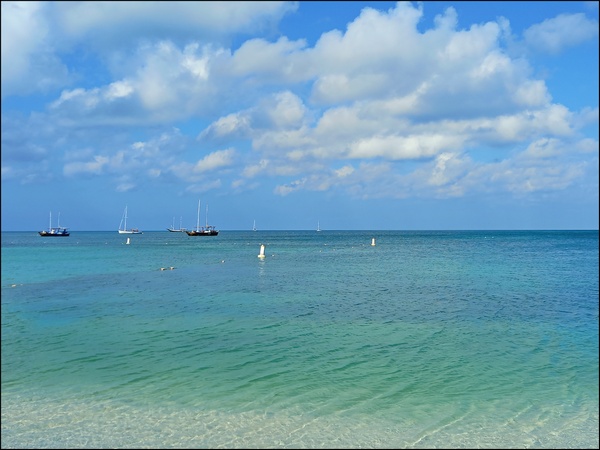
Enjoying the Caribbean Sea at Aruba
There are dozens and dozens of water activities on offer at Aruba’s many beaches. They include both human-powered and motor-powered activities.
Since I’m all about fitness, exercise and natural activities, I’ll focus on the human-powered activities. But for those of you into motorized sea activities, be asured that you can find just about any imaginable water adventure at Aruba, including a variety of boat tours.
Fitness and exercise lovers visiting Aruba can choose from SUP, SUP yoga, wind-surfing, kite-surfing, sea kayaking, sailing, snorkeling and scuba diving. There probably are a few more sports I’m forgetting to mention here, too. But if you’re into natural water sports, you can probably find whatever you most enjoy at Aruba.
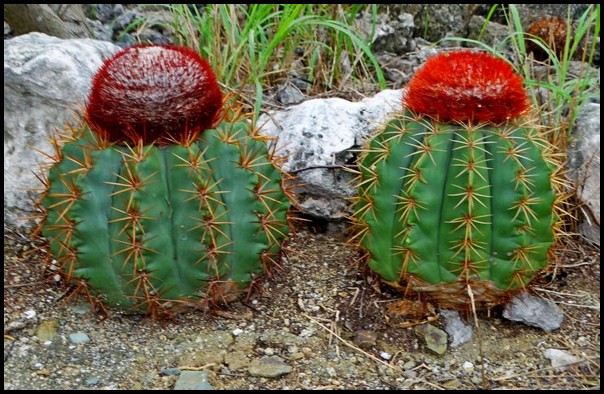
Visiting Arikok National Park
Aruba’s sole national park covers about 20% of the island. It’s located in the central northeastern coast region. There’s an informative park headquarters, several short hiking trails, a low hill, several small wind-battered beaches, caves, blow holes, natural stone bridges and a series of wide dirt roads leading between the attractions.
Enjoying all the walks, landscapes and natural wonders in Arikok N.P. could easily take a full day. Those with less time or stamina could spend a morning visiting the most prominent sites. Be sure to drive a 4WD vehicle through Arikok.
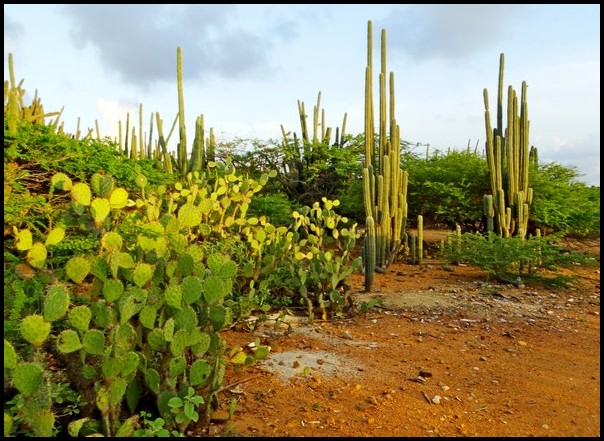
Hiking through Cactus Scrub & Savannah
Aruba’s most prominent vegetation type is cactus scrub. Tall, densely-packed cactii surrounded by low thorny bushes and trees can be seen all over the island. They cover entire hills, huge plains and much of Arikok N.P.
There are many places besides Arikok N.P. to view, photograph and hike through the striking cactus landscapes. Some hiking trails include a short trail at Spanish Lagoon; the much longer Alto Vista Trail, which starts at Alto Vista Chapel in the northeast, near the coast; and undeveloped land in Noord residential areas.
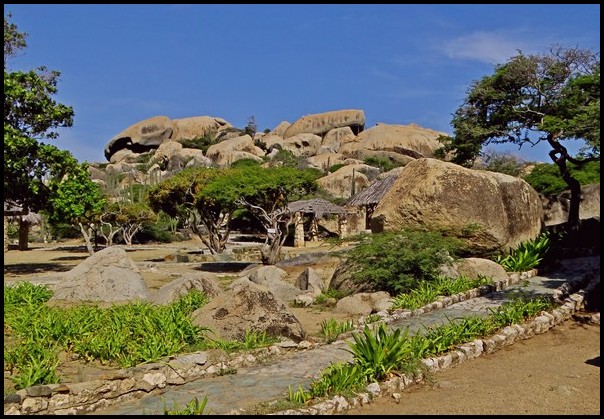
Climbing around Rock Formations
Large groupings of huge scattered boulders and wind-carved rocks are located at several places on the island. The most prominent are Ayo Rock Formations and nearby Casibari Rock Formations. They are both situated more or less in the middle of the island, somewhat northeast of the airport.
Both spots have been made into free public parks, surrounded by stone walls and lightly developed with a series of stone walking paths. At Casibari, the main trail leads up to the topmost boulders, where beautiful views of surrounding cactus scrub and nearby Hooiberg Hill can be seen.
At Ayo, the main trail leads through tunnel-like openings between huge boulders. Unofficial dirt trails lead off through more boulders. Ayo also has ancient petroglyphs painted inside one cave-like rock. It’s free to view those paintings as well.
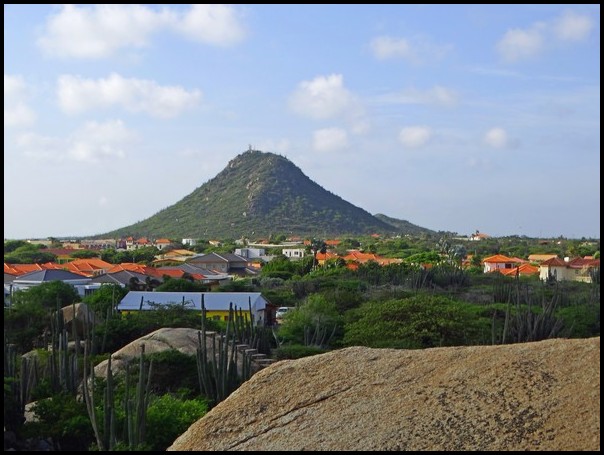
Hooiberg Hill
Hooiberg Hill is Aruba’s sole ‘mountain’, with a modest elevation of 165 M / 540 ft. It’s immediately recognizable as a near-symmetrical volcanic cone poking up from flat land.
Hooiberg Hill is located in central Aruba, just northeast of the airport and close to the above-mentioned rock formations. From the parking lot at the base of the hill, steep stairs lead up the cactus-covered slopes to the top. It’s a strenuous 10-15 minute hike to reach the peak.
At the top, a few glimpses of the island and sea can be caught between tree branches and bushes. Shy wild goats roam the forest-covered slopes, often looking for handouts from visitors.
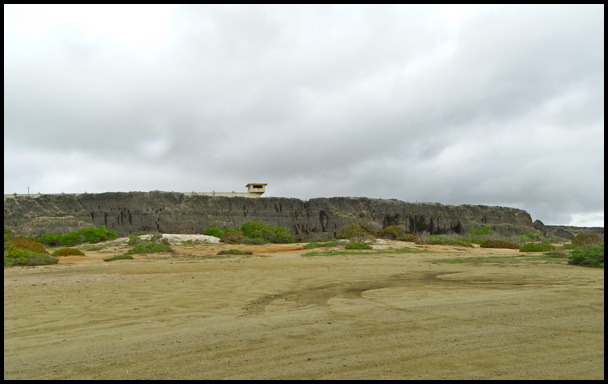
Explore Tall inland Cliffs
At Aruba’s far southeastern coast, inland from Boca Grandi and Grapefield beaches, soaring cliffs rise up from flat scrubby land and continue for about 1.5 miles / 2.5 km. A wide dirt road runs between the coast and base of the cliff wall.
Perched on top, near the southern end of the cliffs, is a large ominous-looking correctional facility. At the northern end is a series of huge wind turbines slowly rotating in the ever-present wind.
The sheer rock wall cliffs feature cracks, caves, strewn boulders and different types of rocks and colorations. Wandering around the base of the cliffs for a couple of hours is a great way to spend a morning on Aruba. You could also check out the long wind-blown beaches and rocky shoreline there.
Sand Dunes
Bare inland sand dunes are located at the northern tip of Aruba and within Arikok National Park. So called ‘White Dunes’ are a popular spot within the national park, while Arashi Dunes, near California Lighthouse, are less visited. Both are fun to walk through.

Inland bodies of water
Aruba island has no natural fresh water nor ground water. There are no rivers, fresh water lakes or springs.
However, there are many small inland salt-water lakes and lagoons (which look like rivers). Following are a few. You can find many others on Google maps or by driving around.
Bubali Bird Sanctuary
Bubali is the largest body of water on Aruba. It’s just inland from Riu Hotel and other large hotels on the west coast.
Bubali is a protected wetlands for birds and there’s a large 3-story wooden viewing tower at the northern end of the ‘lake’. It’s all free to the public.
However, there’s not much to see except during bird migrations in autumn and spring. If you happen to be in Aruba during those times, it’s worth visiting Bubali if you’re into birds.
Spanish Lagoon
This pretty river-like waterway is a calm body of water surrounded by mangrove forest and frequented by saltwater birds like herons and egrets.
There’s a short hiking trail through mangroves then out into cactus scrub. Nearby is the ruins of Balashi Gold Mines.
Spanish Lagoon is located a few miles south of the airport, near the west coast. In fact, the lagoon water flows inland from the sea.
Salt Flats – aka ‘salinas’
In northern Aruba, on Rt 2 just inland from Malmok Beach, there’s a rather large shallow ‘salina’ edged by stark white salt that has evaporated in the sun. If you’ve never seen a salt flat or salt-making area, it’s worth a quick stop. There are several other ‘salinas’ around the island you could check out as well.

Walking & Hiking
I’ve already mentioned several of the best places to walk and hike in Aruba: trails in Arikok N.P., the Alto Vista Hiking/Cycling Trail, Hooiberg Hill and walking at the base of the southeastern cliffs.
In addition, on the long west coast, uninterrupted sidewalks run behind miles and miles of continuous beaches, through hotel grounds and restaurant/bar areas. From Ritz-Carlton, the northernmost resort at the Palm Beach hotel region, all the way down the coast to Drulf Beach in Oranjestad. The total distance is over 5 miles / 8 km.
Of course this is a more developed walking area and perhaps not many people will want to walk that whole distance and back. Popular shorter sections include the Palm Beach hotel region from Ritz-Carlton to the Riu Hotels, a distance of 2 miles / 3.4 km and Eagle Beach, which runs for about 1.2 miles / 2 km.
Heading north from Ritz-Carlton, the main road hugs the coast all the way up to Arashi Beach, about 2 miles / 3.5 km. A wide sidewalk and boardwalks run between the coast and road. This is a stunning all-natural stretch of coast with rocky shores interspersed with tiny beaches.
Aruba’s far northern tip is a vast, completely undeveloped region of low scrub, dunes, rocky coastline and many wide dirt roads. It’s another great hiking area.
Be forewarned that most hiking/walking areas in Aruba are completely exposed to the elements, primarily meaning the hot, intense sun. The hotel region offers some shade along the sidewalks. But it’s probably best to hike in early mornings or in evenings after about 6pm.

Cycling
Aruba is a great island for cycling, both on and off-road. Roads are flat and there are several places to cycle off-road, mostly on wide dirt roads. Several tourist businesses rent bicycles.
The only drawbacks to cycling on Aruba are the island’s constant wind, high temperatures and the intense sun. So be careful with the weather. Probably the best time to cycle is in early morning before 9 or 10 am.
Cycling on roads in Aruba is great, except perhaps in Oranjestad town and the traffic-laden hotel area between Oranjestand and Palm Beach to the north. Roads in Noord area (north of Palm Beach) have little traffic and fantastic views. Side roads and residential areas also generally have little traffic.
For off-road cycling, great areas include the island’s far northern tip, north of California Lighhouse, various dirt roads on the long east coast, Alto Vista Hiking/Cycling Trail, and the far southeastern coast.
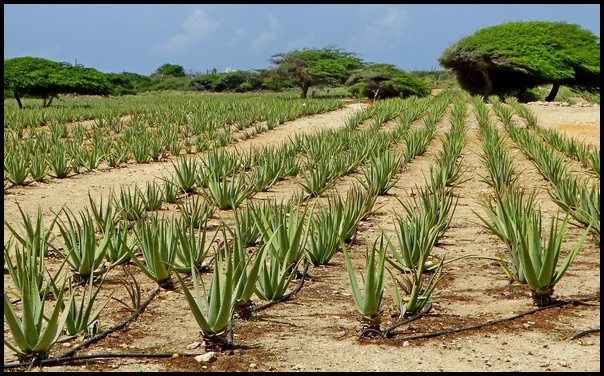
Warnings for outdoor adventures on Aruba
Weather
Aruba is very hot, with intense sun, year-round. Daytime temperatures are mid-80s to upper 90s F / 30-34 C, year-round. On top of that, humidity is high (75-90%) and the sun is extremely direct and intense. That all makes the temperature feel considerably hotter, especially in afternoons.
A mild to strong, gusting wind blows across Aruba nearly every day, making things feel slightly cooler. However, don’t let the cooling wind distract you from the intense sun rays.
When you’re outdoors, especially when doing any strenuous exercise, be sure to either cover up or use good sunscreen. Carry and drink plenty of water. Use electrolytes. Limit your exposure to the heat and sun. Remain aware of how you’re feeling so as to avoid dehydration, heat-exhaustion or heat-stroke.
It’s probably best to engage in outdoor activities in the cooler morning & evening hours and avoid afternoons.
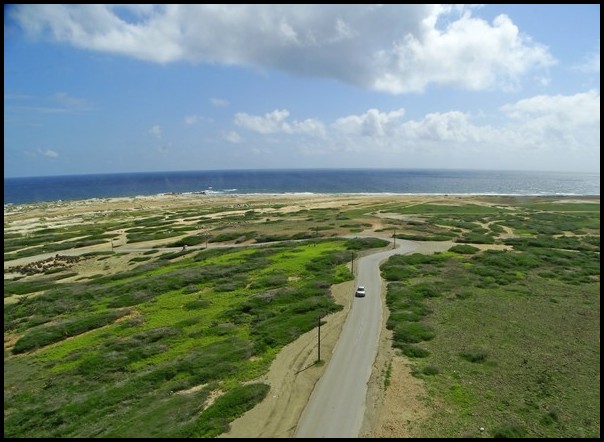
Access to Nature Spots
Aruba does have a public bus system. However, buses only go between Oranjestad and particular destinations.
To reach most of the places I’ve written about in this article, you’ll need your own transportation. Rental cars and on-road ATVs are readily available. Keep in mind that they are expensive, as is gasoline.
Also be advised that at Aruba’s northern tip, southern tip and most of the northeastern coast many of the dirt roads require 4WD vehicles. If you plan to explore those areas, rent a 4WD.
==================================
You might also enjoy:
10 Surprising Facts about Aruba
====================================







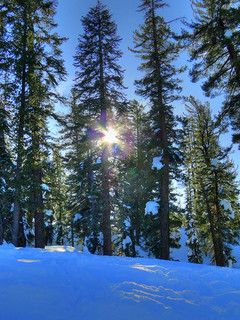

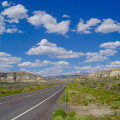


 Hi! I'm Lash, an American nomadic world traveler who's been traveling solo since 1998. I’m passionate about traveling the world nomadically and then sharing it all with you. I hope to inspire you to travel the world, to entertain you with tales from the road, and to help you reach your travel dreams. Welcome!
Hi! I'm Lash, an American nomadic world traveler who's been traveling solo since 1998. I’m passionate about traveling the world nomadically and then sharing it all with you. I hope to inspire you to travel the world, to entertain you with tales from the road, and to help you reach your travel dreams. Welcome! 




1 pings
10 Money Saving Tips for Aruba - LashWorldTour
2021/10/19 at 4:42 am (UTC 8) Link to this comment
[…] « Natural Aruba: All the Best Nature Places & Activities on the Island […]